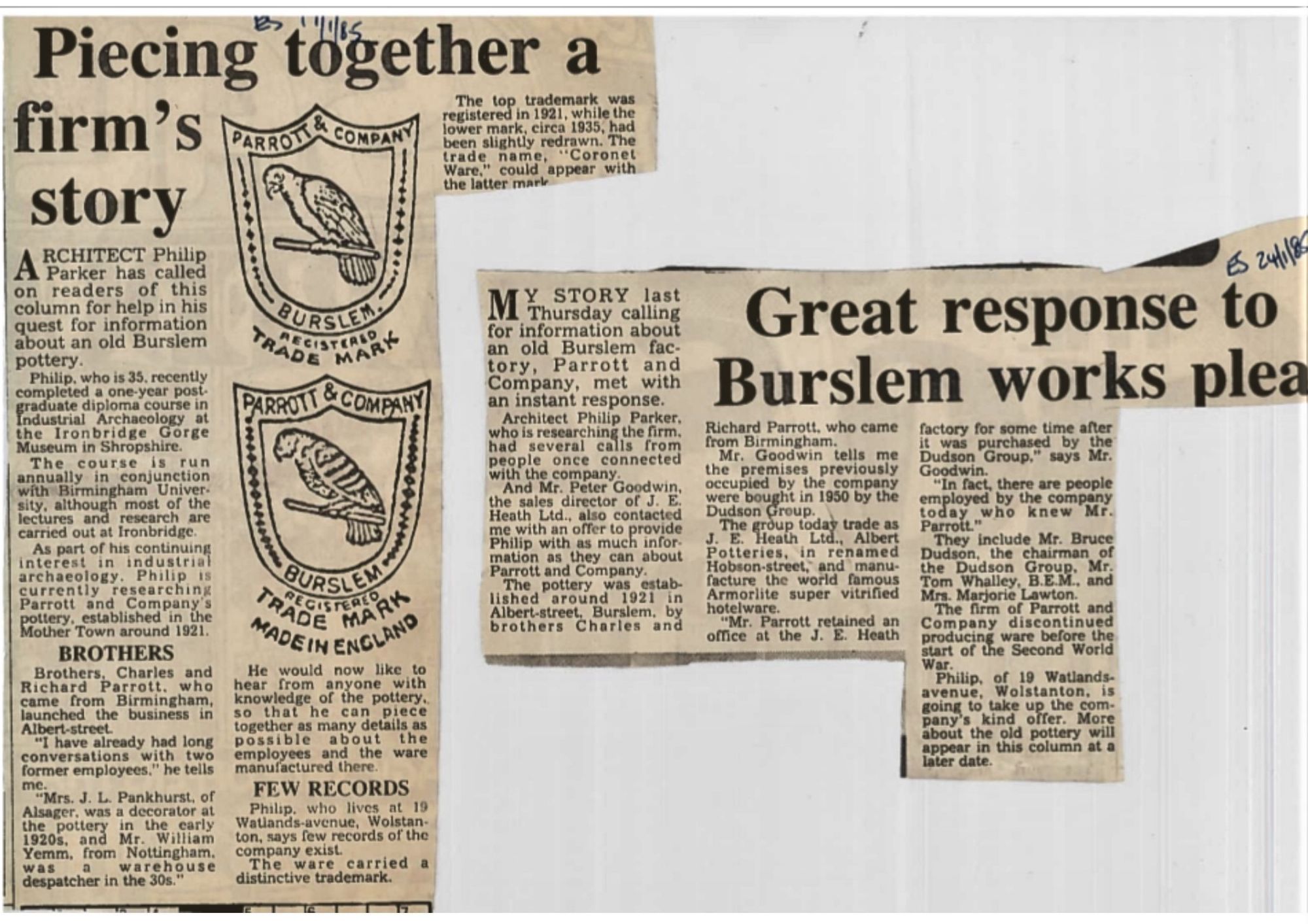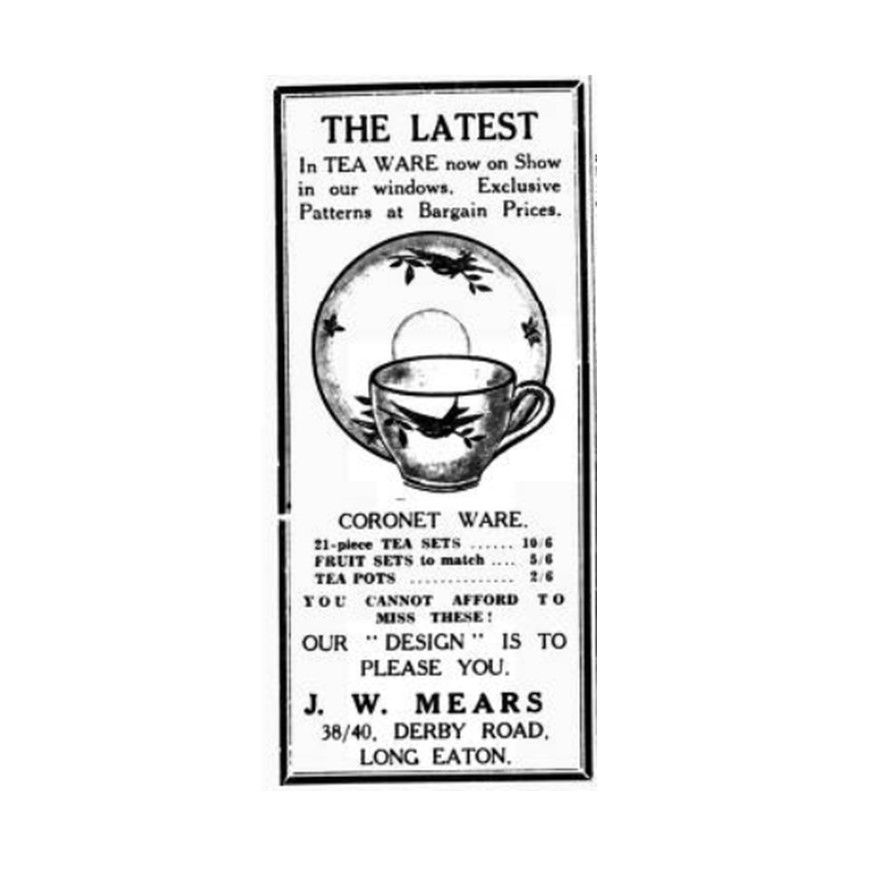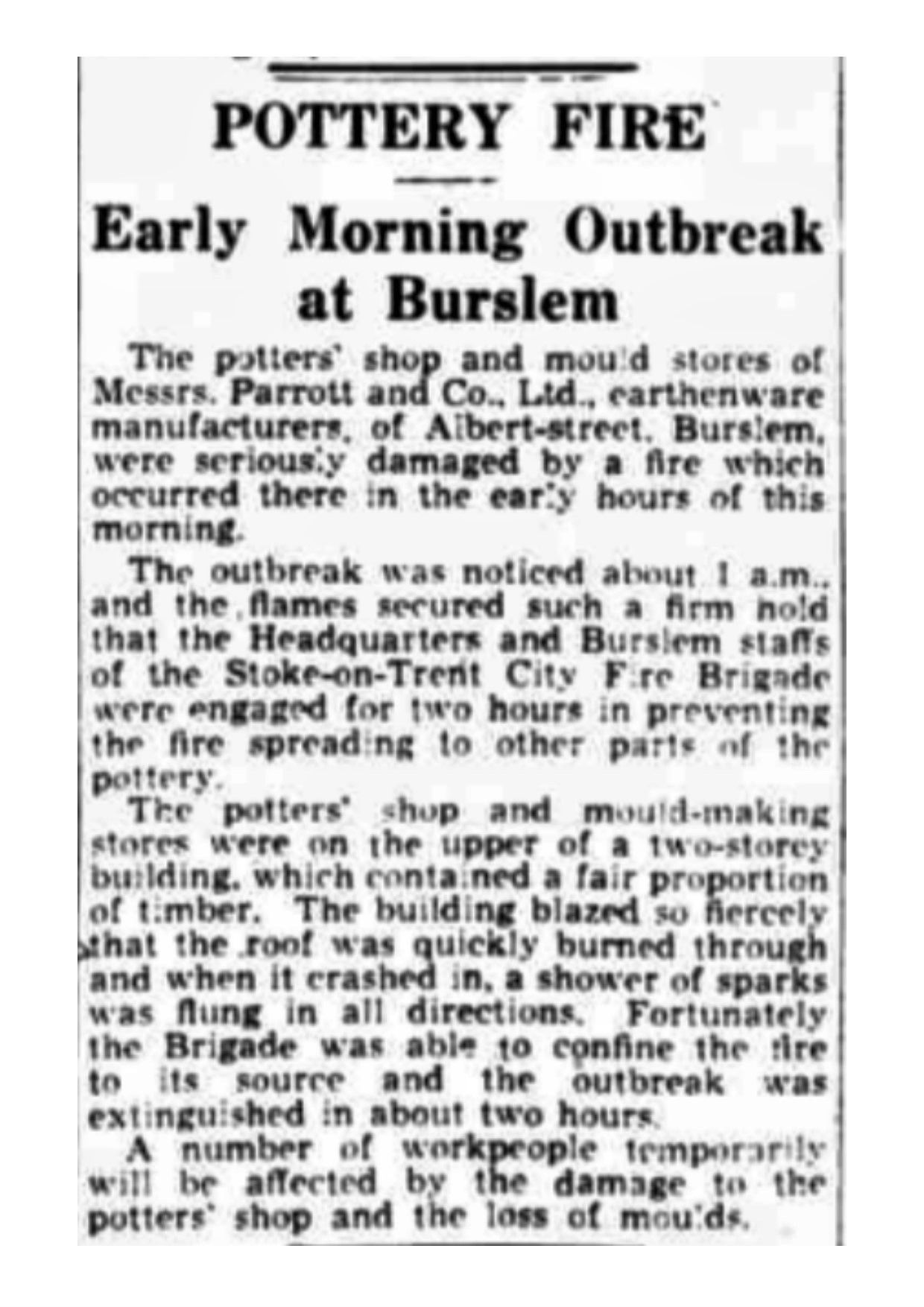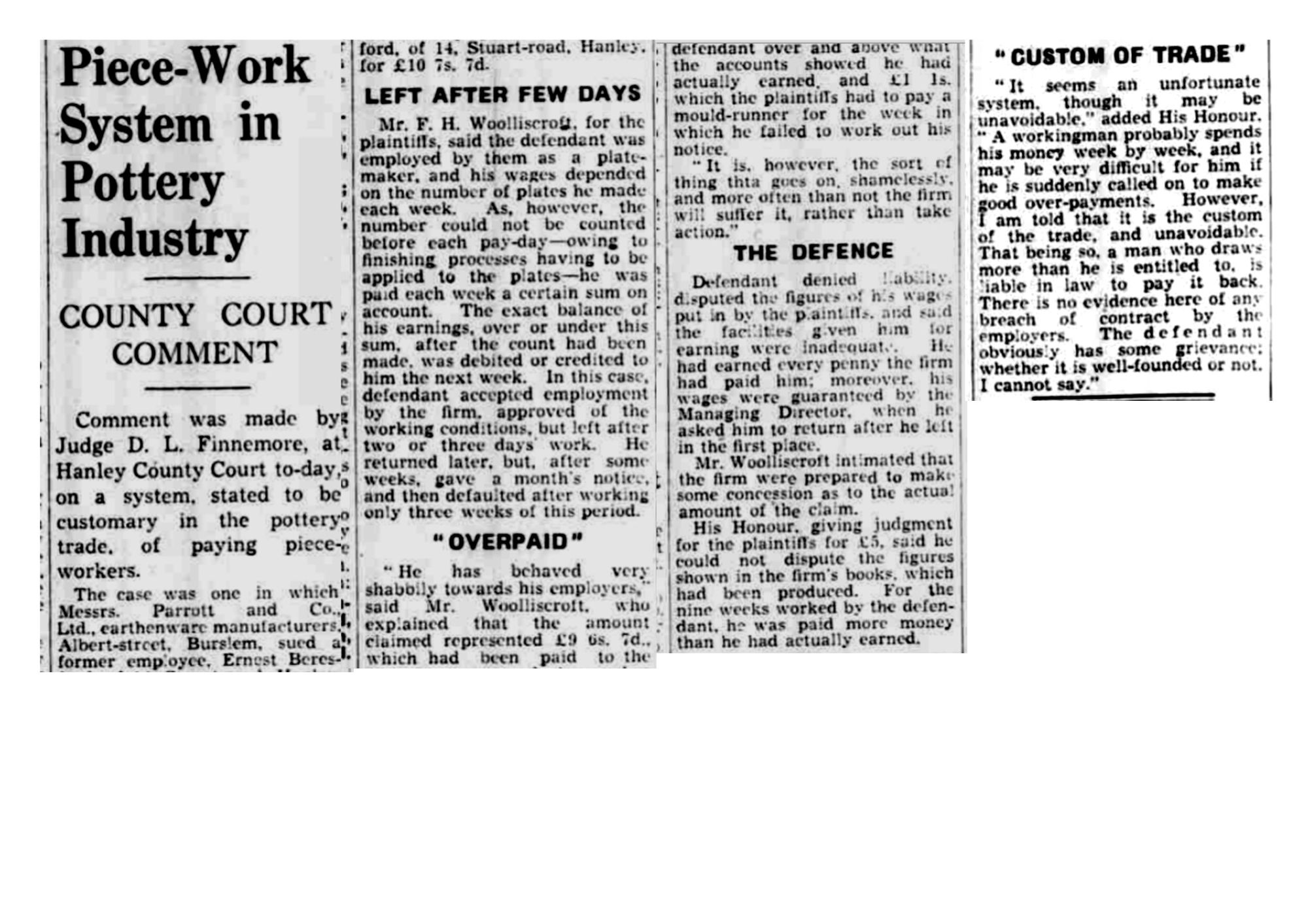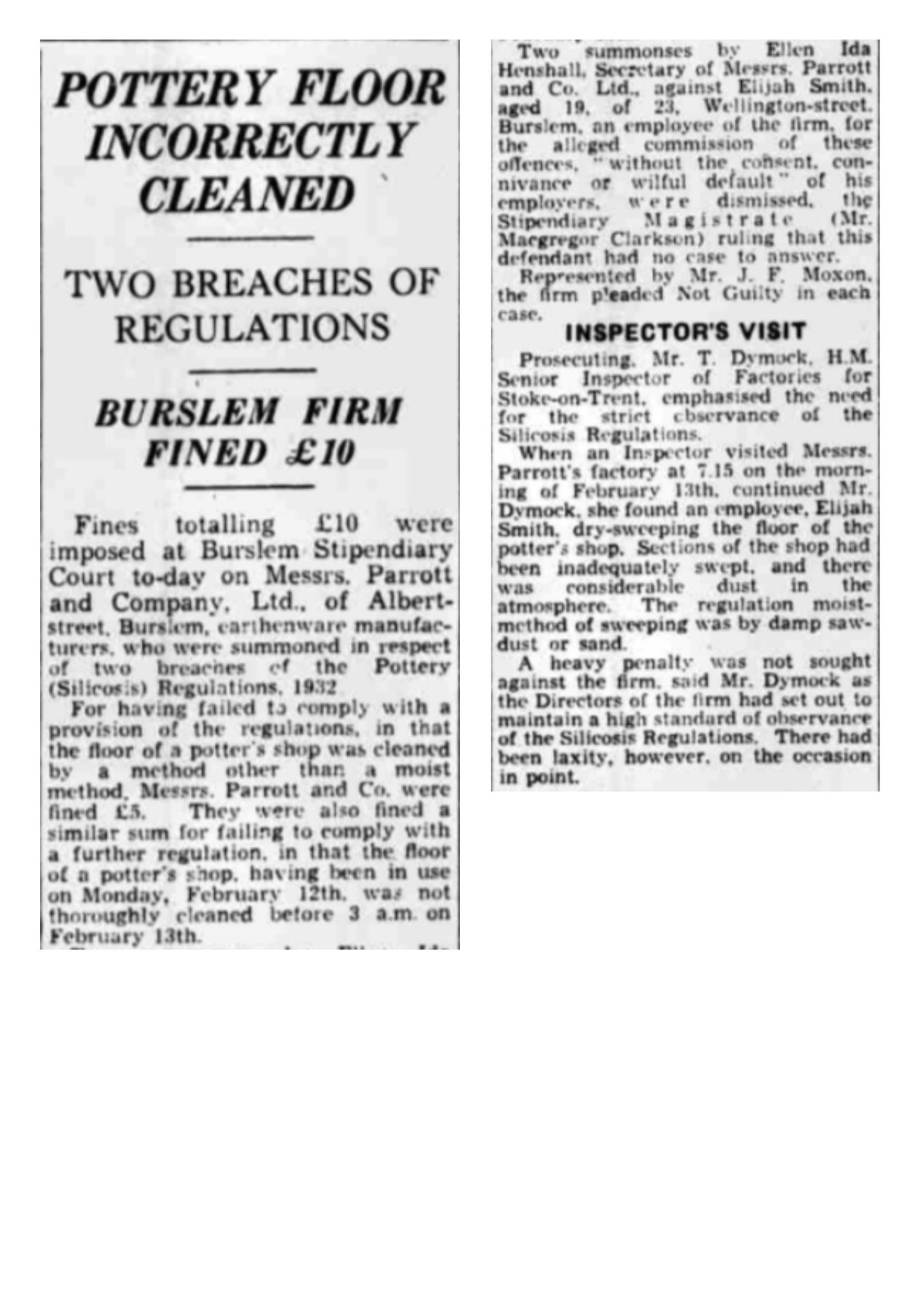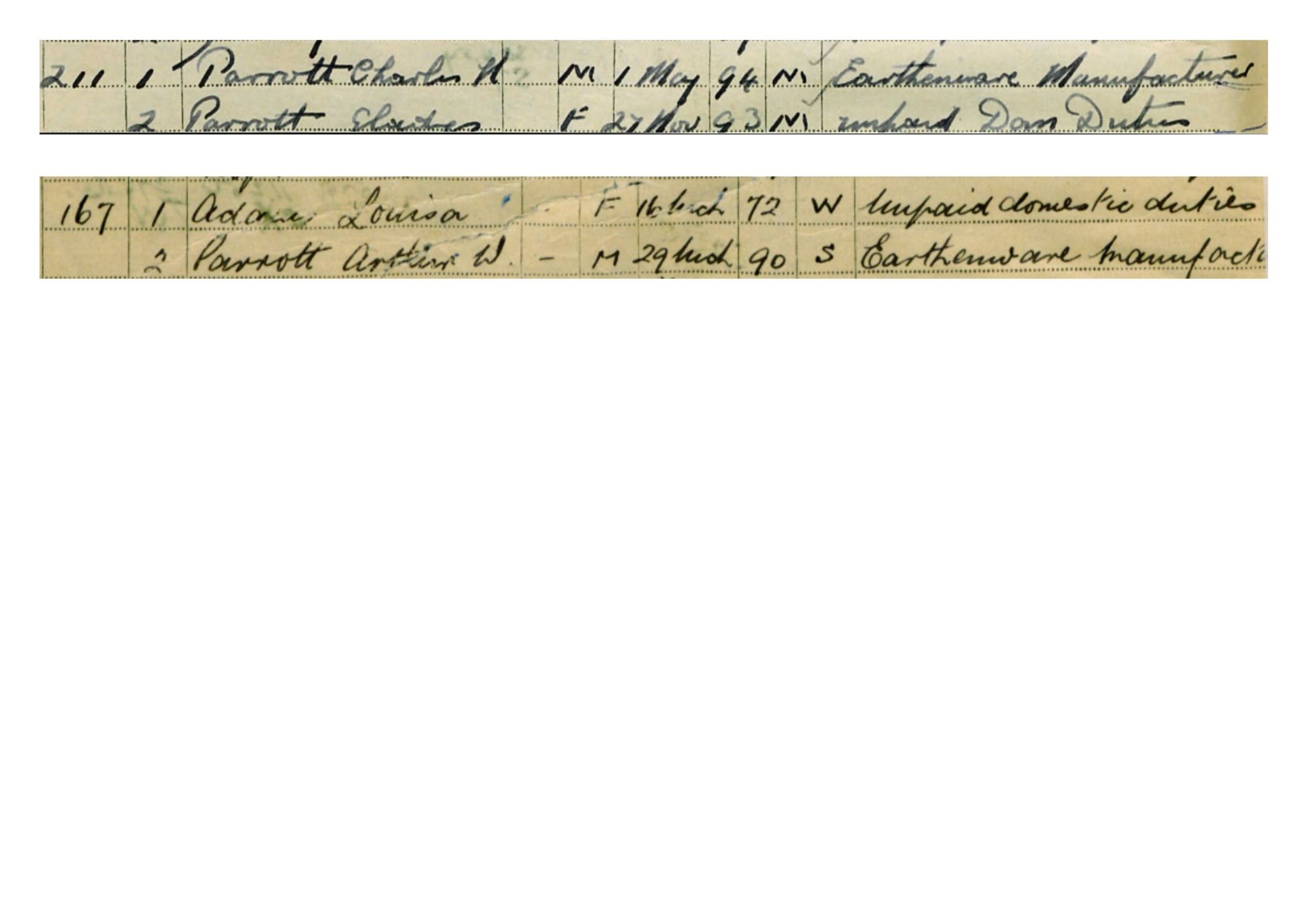History
Charles Henry Parrott was born 1 May 1894 near Leek in Staffordshire and Arthur William Parrott was born 29 March 1890 at Pinner in Middlesex. They were brought up in Leek, where their father, of modest means, had a little pottery shop. Both boys had only a basic education. Arthur was the older by four years.
In 1911 Arthur William was working as a China and Glass Shop Assistant whilst his brother Charles was working as a Railway Clerk, both being boarders in Birmingham Sparkbrook. Both brothers served in the First World War, Charles in the Tank Corps and Arthur as a Gunner in the Royal Field Artillery. The brothers launched their earthenware business in Albert Street, Burslem, circa 1921, after Charles left the army in 1920.
In 2023 Michael Parrott aged 93 (son of Charles) kindly recounted the personalities of his father and uncle. "Charles was very direct and had a fearsome temper. You could see the veins in his forehead pulse when he got mad. But he was straightforward. He told you exactly what he thought right to your face. He was also a stickler for time. If we were going out he said we will leave at ten. At ten he would get in the car a drive off. If you weren't there then you didn't get to go! Also at work if someone came late for an appointment he wouldn't see them" .
"Arthur never showed temper but if you crossed him he would get back at you no matter how long it took". Arthur never married although he was one with a bit of a reputationfor the ladies.
"The brothers worked well together but they had almost no social contact otherwise. Arthur never came to our house for a meal. Occasionally in the summer I would see his car in the driveway and he would be sitting on a wooden box weeding a crazy-paving path behind the house. After he had had enough he would leave without making any contact. Charles liked gardening and would dress accordingly but Arthur always wore a suit and his concession to gardening was to take his jacket off and turn his shirt cuffs back. I don't think he had any sport or casual clothing. He once went for a holiday but came back after two days saying "There was nothing to do", meaning business I suppose".
"The brothers also knew Clarice Cliff and Susie Cooper. I don't think Clarice Cliff did any designs for them but I think Susie Cooper did. Susie Cooper came to our house for dinner once (I wasn't included...had my dinner in my room on a tray) I got the impression of flowing fabrics and lots of color. I think my mother thought Susie's sights were on Arthur!!"
The firm of Parrott & Company discontinued manufacturing wares shortly after the start of the Second World War.around 1940.possibly due to conscription of its employees.A precise date for when production finally ceased is not known so far but it seems some form of production continued into the early 1960s mainly decorating bought in blanks.
During the spring of 1939 the deteriorating international situation forced the British government under Neville Chamberlain to consider preparations for a possible war against Nazi Germany. Plans for limited conscription applying to single men aged between 20 and 22 were given parliamentary approval in the Military Training Act in May 1939. This required men to undertake six months’ military training, and some 240,000 registered for service. Then on the day Britain declared war on Germany, 3 September 1939, Parliament immediately passed a more wide-reaching measure.The National Service (Armed Forces) Act imposed conscription on all males aged between 18 and 41 who had to register for service. Those medically unfit were exempted, as were others in key industries and jobs such as baking, farming, medicine, and engineering.
The pottery was eventually absorbed into Burgess and Leigh around 1941 under the Wartime Concentration Scheme. [During the 20th Century, Burgess and Leigh became known as ‘Burleigh’].after the beginning of World War Two. They became a nucleus pottery at the outbreak of World War II, Parrot & Co was fairly small and so they ceased production, they made their pottery and they just run an office with basic staff to administer sales. Moulds, and patterns came to Burgess & Leighs premises and were used alongside their own shapes and patterns, with a production cost coming to 'Burgess & Leigh' after sales went out. The idea of this set up was to allow smaller companies to keep going during the war when staff shortages made full production difficult, factory workers that remained worked together. When a very different world emerged post war, few of these companies started back up on their own feet. Parrot & Co was one such example. The company did not merge it simply ceased to exist, other than in the moulds and patterns that remained with Burgess & Leigh to this day. After the war the business moved back to the Albert Street Pottery.
Parrott & Co original premises were purchased in 1950 by the Dudson Group who thereafter traded as J E Heath & Company, in the renamed Hobson Street.It appears that after the war the business of Parrott & Co. concentrated on decorating blanks made by others. Godden 'Encyclopaedia of British Pottery & Porcelain Marks' 1964 - records "The manufacture of pottery has been discontinued"
The business was known to be in operation, in some form, in 1960 - it was recorded in the 1960 Pottery Gazette Reference Book & Directory as a manufacturer of "dinner ware, tea ware, chambers, coffe ware, fruit or dessert sets, pudding basins, sandwich set, teapots (earthenware, decorated)" A. W. Parrott was recorded as the Proprietor.
Charles retired then and moved to Ilfracombe. Arthur continued in the business.
Little is known of the staff especially the designers. The woman who was chief of the office staff at Albert Street was called Ellen Ida Henshall - The manager of the works in the 30's was named Bently (Bentley).
As no factory records remain in so far as is known, only a few pattern names are known where printed on the items produced. Likewise nothing is known about the intended use of some items, who designed them and when they were manufactured. It is to be hoped that as a result of this web site more information will come forward. I would be grateful to hear from anyone who can assist. with any further information.
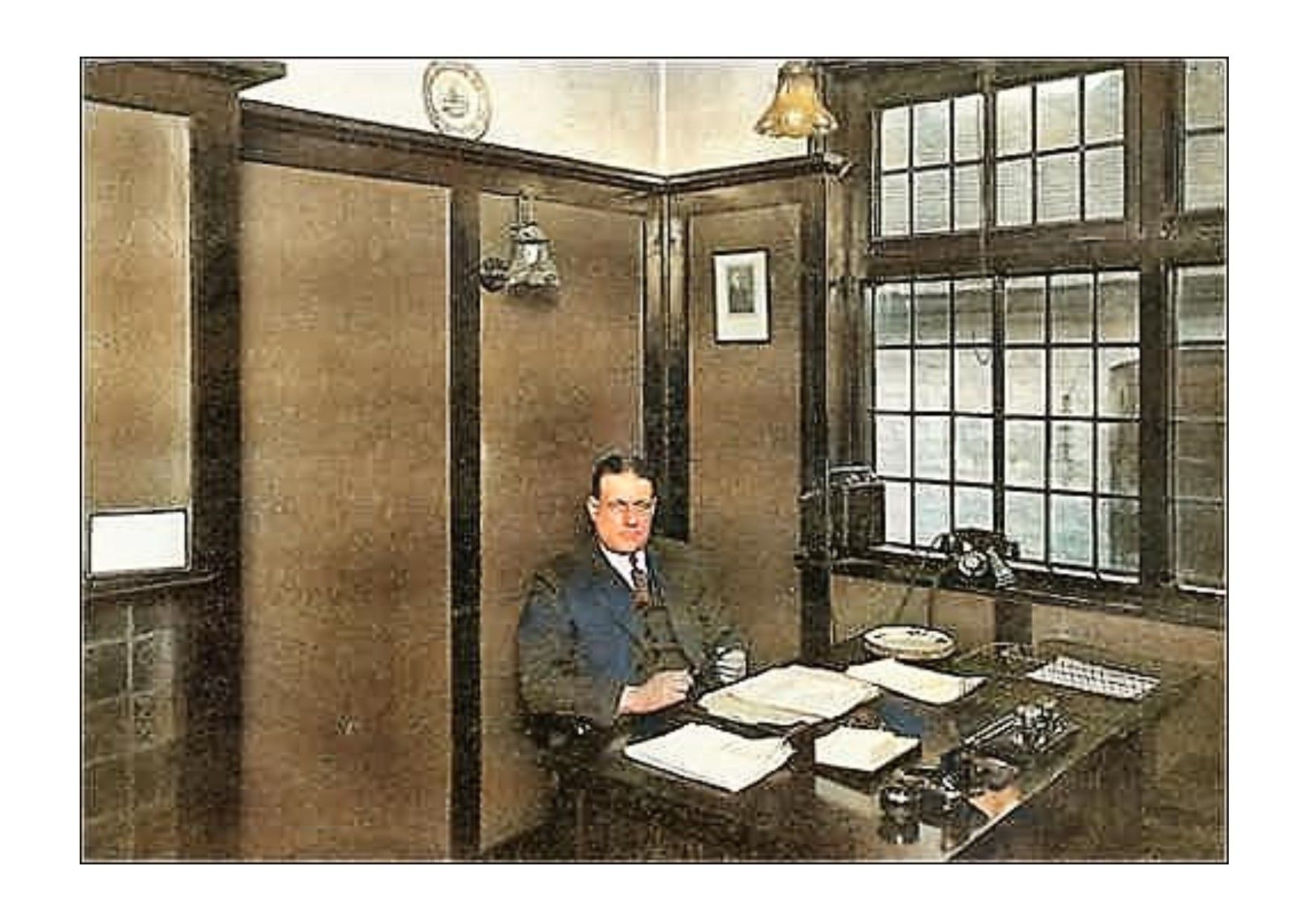
Charles Henry Parrott
Charles was born 1 May 1894 - died on 24 October 1965 (Colourised photograph)
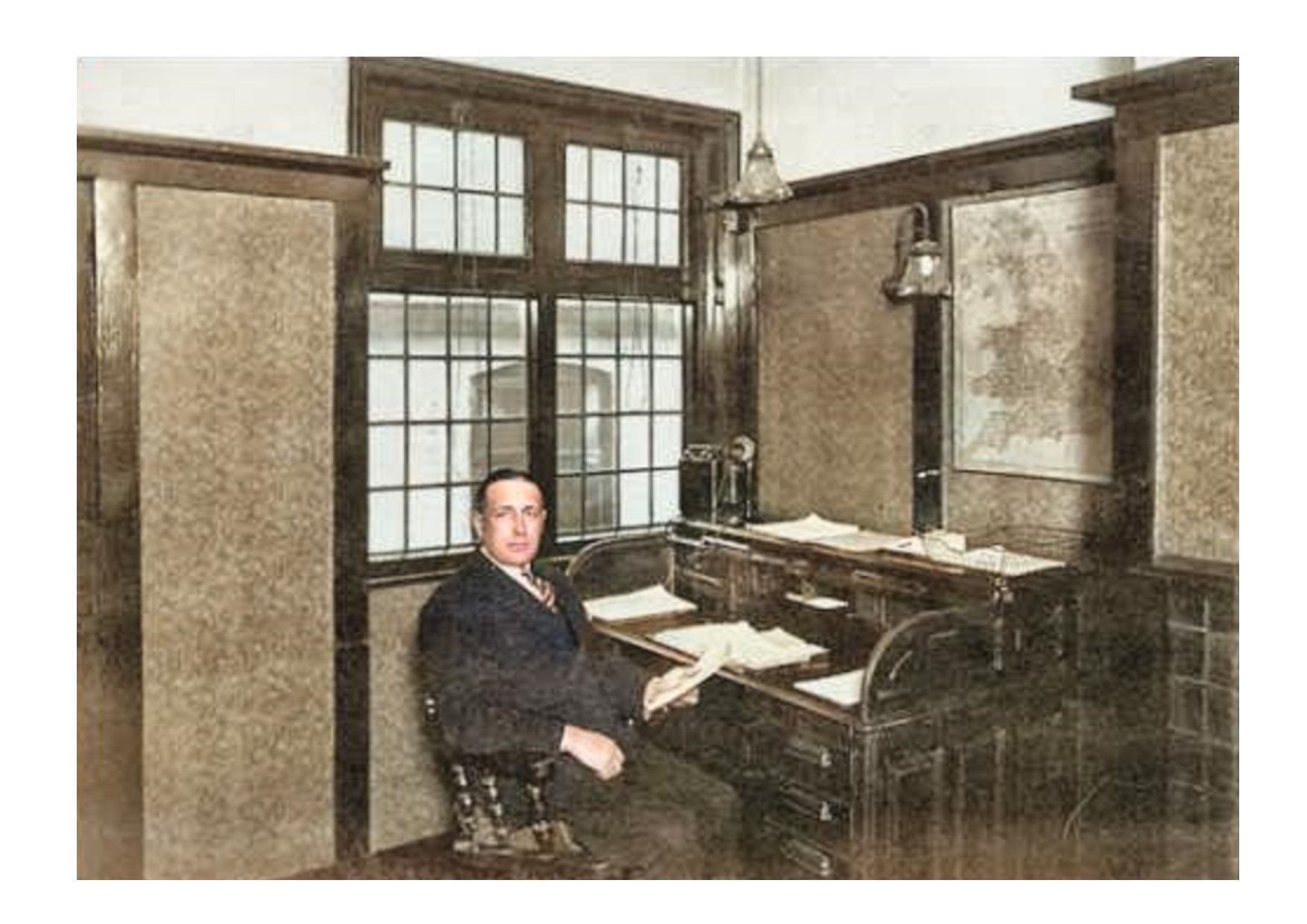
Arthur William Parrott
Arthur was born 29 March 1890 - died on 5 January 1959 (Colourised photograph)

teapot makers
Photograph taken in 1920s - Taken from the Gladstone Pottery Museum Photographic Collection

Arthur William Parrott
Arthur was born 29 March 1890 - died on 5 January 1959 (Colourised photograph)
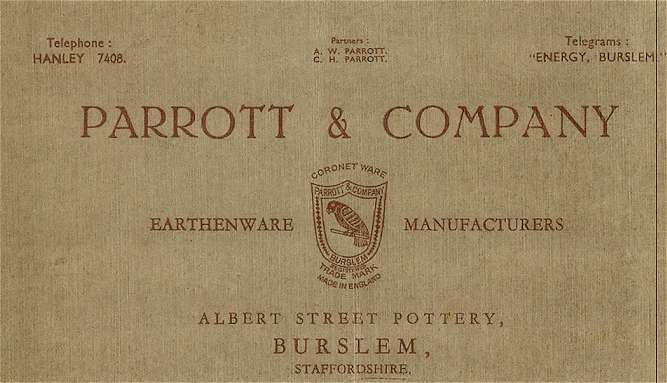
Booklet Cover
PARROTT & CO BOOKLET reproduced by kind permission of Steve Birks who runs a large informative site on the Potteries (click to link)
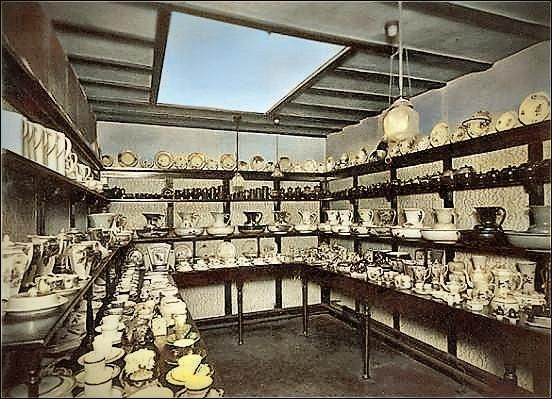
Showroom
PARROTT & CO BOOKLET (Colourised photograph)
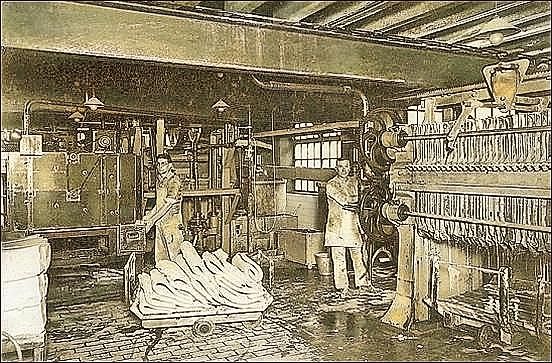
Clay Making
PARROTT & CO BOOKLET (Colourised photograph)
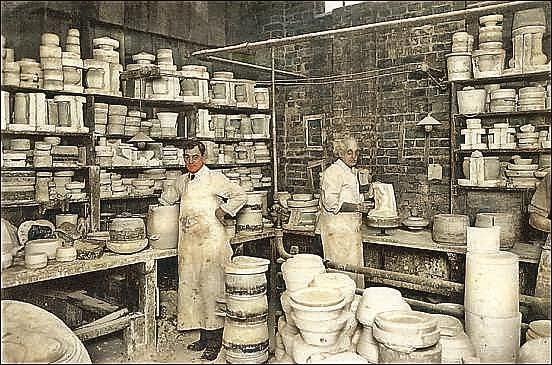
Mould Making
PARROTT & CO BOOKLET (Colourised photograph)
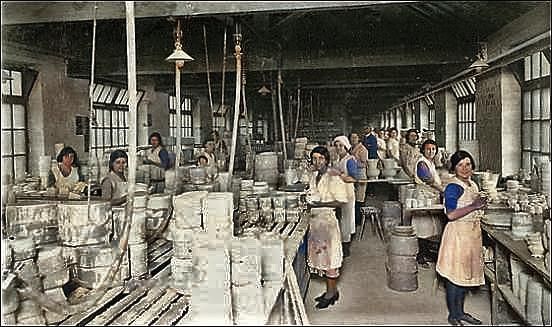
Casting Shop
PARROTT & CO BOOKLET (Colourised photograph)
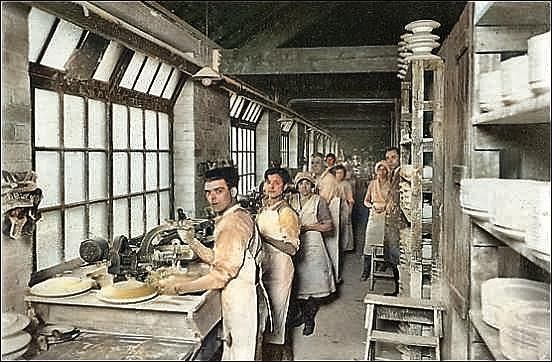
Plate Making
PARROTT & CO BOOKLET (Colourised photograph)

Dipping House
PARROTT & CO BOOKLET (Colourised photograph)

Placing in Saggars
PARROTT & CO BOOKLET (Colourised photograph)
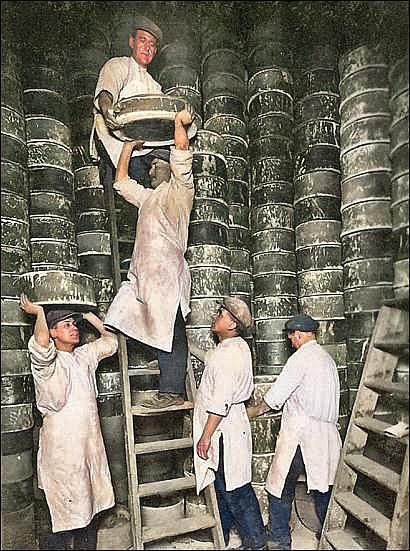
Placing inside Ovens
PARROTT & CO BOOKLET (Colourised photograph)
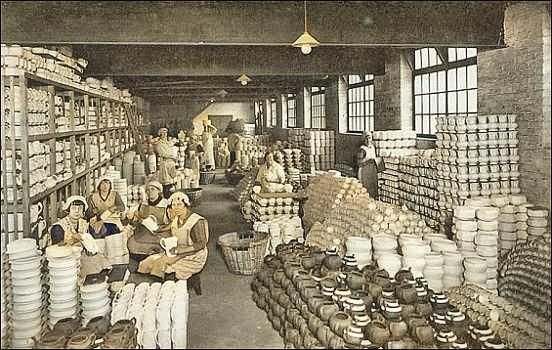
Bisque Warehouse
PARROTT & CO BOOKLET (Colourised photograph)
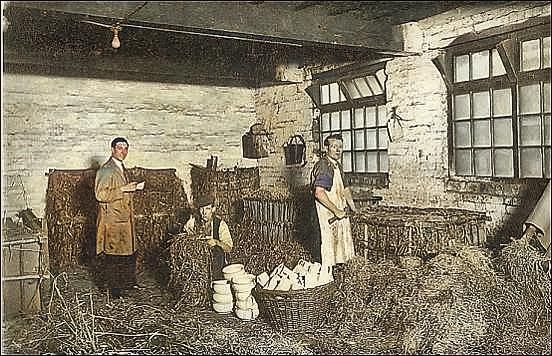
Packing
PARROTT & CO BOOKLET (Colourised photograph)
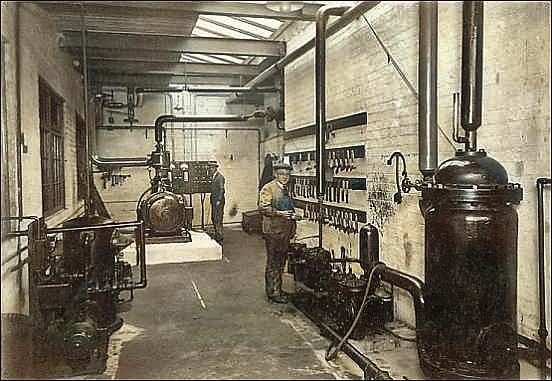
Power House
PARROTT & CO BOOKLET (Colourised photograph)

